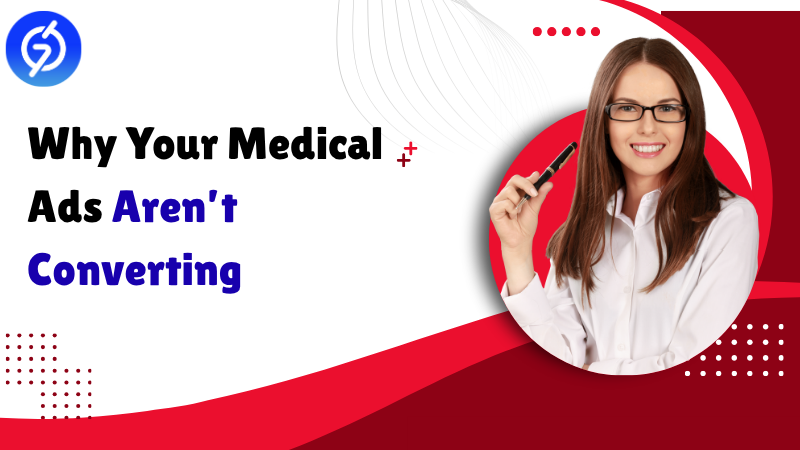What to Do When Your Medical Advertising Isn’t Converting
So, your Medical Advertising campaign isn’t performing the way you hoped. You’ve spent hours perfecting visuals, messaging, and targeting, yet conversions are barely trickling in. You’re not alone — nearly 70% of healthcare advertisers report struggling to achieve consistent ROI from their medical ads. It’s a common frustration in a sector where compliance, credibility, and competition collide.
The medical marketing industry is projected to surpass $45 billion globally in 2025, yet many advertisers still find themselves stuck in campaigns that don’t generate results. Why? Because traditional marketing logic doesn’t always apply here. The audience, the message, and even the platforms operate differently. To uncover what’s going wrong — and how to fix it — let’s dive into what’s really driving (or stalling) conversions in today’s healthcare ad landscape.

Diagnosing Healthcare Advertising Challenges: The Prescription for Success
One of the biggest mistakes advertisers make is using the same approach across industries. You can’t treat healthcare like eCommerce. It demands empathy, authority, and accuracy. Platforms like the Best PPC Ad Platform for Medical Advertising understand these differences and offer built-in solutions to help campaigns perform in this unique environment. They’re designed for healthcare advertisers who want to balance compliance with results, giving you a structure that works in reality, not just in theory.
Poor Audience Targeting
Let’s start with the most fundamental issue. Many advertisers fail to define who their real audience is. If your medical ads are targeting everyone, you’re effectively reaching no one. For example, a campaign for a cardiac monitor shouldn’t be aimed at general fitness enthusiasts. Instead, it should target healthcare professionals, hospital procurement officers, or patients in a specific demographic with heart conditions.
Know Your Patient Persona
Think of your audience not as “users” but as “patients or professionals seeking trust.” Refine your persona. Use data to understand what they search, what motivates them, and what language they respond to. The more precise your targeting, the better your conversions. Healthcare audiences want clarity, proof, and relevance — not generic messaging.
Messaging That Lacks Credibility
In healthcare marketing, trust is everything. People won’t click on flashy, exaggerated promises. If your ad sounds too promotional, it may trigger skepticism. Audiences today crave transparency and facts, especially when it comes to health.
Whether you’re advertising medical devices or promoting a telehealth platform, credibility should shine through your copy. Use patient testimonials, verified data, or clinical facts. Simple, honest messaging can outperform overly creative slogans because it feels more authentic.
Use Educational Messaging
Instead of pushing a product, share valuable information that builds authority. Ads that educate tend to have higher engagement rates. Combine your message with blog content or explainer visuals that add context and demonstrate care for the audience.
The Landing Page Disconnect
Even if your ad is performing well, conversions often fail because of a poor landing page experience. Your audience may click but then leave within seconds if the landing page doesn’t match the ad’s promise. This disconnect leads to wasted ad spend and low ROI.
Optimize for Intent
Ensure that your landing page continues the conversation your ad starts. If your ad promotes a specific treatment or device, the landing page should offer detailed information, visuals, and a simple contact form. Consistency between ad and landing page can improve conversions by up to 40%.
Not Using the Right Platform
Not every ad network understands the sensitivities of medical marketing. Mainstream ad platforms often reject healthcare-related campaigns due to strict guidelines. This leads to frustration and underperformance. Specialized solutions like a medical ad network cater specifically to this niche. They allow compliant promotion of healthcare services, devices, and apps while ensuring visibility among relevant audiences.
Go Where Compliance Meets Conversions
Healthcare advertising requires safe, credible spaces where both advertisers and audiences feel confident. Dedicated networks help achieve that by maintaining high editorial standards and ensuring ads reach medically-relevant publishers. This enhances not only conversion rates but also long-term brand reputation.
Overlooking Data and Conversion Tracking
Another big issue in underperforming campaigns is a lack of proper data analysis. Many advertisers set campaigns live and wait for results without diving into what’s actually happening. Conversion tracking isn’t optional — it’s your diagnostic tool.
Measure the Metrics That Matter
Beyond clicks, track lead form submissions, consultation bookings, and call inquiries. These are the true conversion indicators for healthcare. Understanding which keywords, creatives, or demographics bring the best results lets you adjust and optimize campaigns efficiently.
Ignoring the Role of Content in Conversion
Ads don’t convert in isolation. In healthcare, content marketing plays a supporting role. When potential patients or clients click your ad, they often research further before taking action. If your website lacks authoritative blogs, guides, or videos, you lose them in the middle of the funnel.
Incorporate informative content on your site. For example, link ads about a new treatment to an article that explains how it works. You’re not just selling — you’re guiding. This builds emotional connection and trust, both vital for healthcare conversions.
Weak Call-to-Actions (CTAs)
Many medical advertisers use generic CTAs like “Learn More” or “Click Here.” While simple, they fail to create urgency or clarity. Instead, use action-driven CTAs tailored to your offer. For example, “Book Your Free Consultation,” “Get Device Demo,” or “Talk to a Specialist.” Personalized CTAs align with user intent and significantly lift conversion rates.
Once your campaign is structured properly, it’s time to scale with the right partner. If you’re ready to relaunch your healthcare campaigns with smarter targeting and real conversions, you can Start Medical Ad Campaigns Now.
Failing to Adapt to Market Shifts
The healthcare landscape changes quickly. Patient behavior today is influenced by social media, wellness trends, and digital trust. Advertisers who don’t update their campaigns frequently risk losing traction. Regular A/B testing and fresh creatives are key to keeping engagement high.
Test, Learn, and Iterate
Every ad, landing page, and message offers data. Use it. Run split tests on headlines, visuals, or targeting groups. Measure performance weekly. The difference between a failing and a thriving campaign often lies in continuous optimization.
Overcomplicated Conversion Funnels
Sometimes your campaign doesn’t need more exposure — it needs simplification. Complex funnels with multiple steps can kill conversions. In medical advertising, users prefer clarity. If someone has to fill out five forms just to book an appointment, they’ll likely abandon halfway.
Streamline your conversion path. One clear message, one action button, and a single form field can make a huge difference. Simplify, and you’ll often see an immediate lift in leads.
Focusing Only on Short-Term Results
Finally, remember that medical advertising builds trust over time. Healthcare buyers and patients are cautious — they research, verify, and then act. Focusing only on short-term ROI can blind you to long-term opportunities. Stay patient. The right strategies compound over time, bringing not just conversions but loyal, returning customers.
Turning Frustration into Growth
If your campaigns aren’t converting, it’s not a failure — it’s feedback. Each click, bounce, or impression tells you something about what to improve. The key is to listen, learn, and act. In 2025, the most successful advertisers will be those who combine data, empathy, and creativity to reach the right people with the right message.





